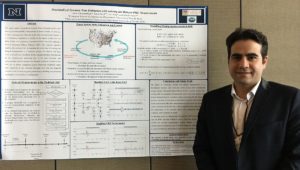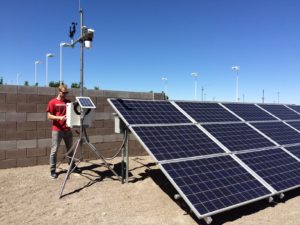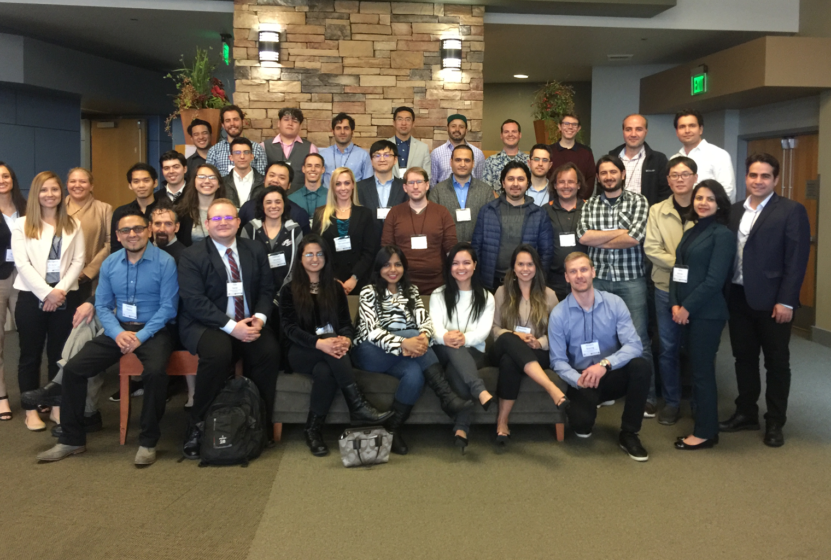Graduate Student Research Builds the Foundation of Sustainable Solar
Students display their research for the interdisciplinary NEXUS project at the annual meeting’s poster session
By Jane Palmer
Mid-April, 2018
NEXUS graduate student research covers all bases when it comes to preparing for a clean and sustainable future. The students’ research serves to support and advance Solar Nexus’ mission, as their projects aim to increase solar energy efficiency and investigate the impacts of utility solar energy plants on the environment and water resources. Students are also investigating the creation of a secure cyberinfrastructure and are analyzing the economics of different styles of solar energy production.
By May 31, 2018, 41 students will have graduated during the five years of the interdisciplinary NEXUS project. At the 2018 Solar Nexus annual meeting, many of these graduate students convened to display their research contributions during the meeting’s poster session.
“Our graduate students are skilled junior partners in carrying out NEXUS experiments, making the measurements, developing new ideas and knowledge and are key to our scientific and engineering productivity,” says Dr. Gayle Dana, Project Director. “They are the upcoming generation of researchers and innovators and will be the mentors and instructors of further generations of young people.”
A few highlights from the poster session are below. To view the all the student poster abstracts please click here.
Understanding How Solar Panels Impact the Hydrology of Desert Soils
 Arrays of solar panels might be stationary but in subtle, and not so subtle ways, they can influence the delicate hydrological balance of desert soils. When NEXUS graduate student Yuan Luo of the Desert Research Institute and his supervisor, NEXUS scientist Dr. Markus Berli first began to investigate the impacts of solar panel arrays on the surrounding hydrology they found that the panels channeled rainfall into concentrated drip lines. When droplets land on the panel, the earth immediately below the panels remains dry, but the water then runs down the panel slopes and drains into the ground at the end of the panel edges and in the cracks between the panels.
Arrays of solar panels might be stationary but in subtle, and not so subtle ways, they can influence the delicate hydrological balance of desert soils. When NEXUS graduate student Yuan Luo of the Desert Research Institute and his supervisor, NEXUS scientist Dr. Markus Berli first began to investigate the impacts of solar panel arrays on the surrounding hydrology they found that the panels channeled rainfall into concentrated drip lines. When droplets land on the panel, the earth immediately below the panels remains dry, but the water then runs down the panel slopes and drains into the ground at the end of the panel edges and in the cracks between the panels.
The scientists’ models demonstrated how the panels changed the way rainfall fed into the soil but the team realized that the science community’s understanding of the movement of water in the desert soil near to the surface is still relatively limited. “This is an important knowledge gap since desert soils cover about one third of the Earth’s land surface and some of the fastest growing human developments are located in deserts,” Luo says.
The team then set out to investigate this knowledge gap. To do so they are working to improve a soil physics model HYDRUS-1D. The model successfully simulates water infiltration, redistribution and evaporation for moist soil conditions but systematically underestimates these variables when the soil is dryer. The scientists plan to enhance this model by improving the model’s water retention and hydraulic conductivity function.
“We are trying to push our model to more extreme dry conditions,” Luo says. “In this way, we would be able to better understand the moisture dynamics in the near surface soils, which will help to address various topics like ecosystem restoration, flood control, and dust suppression.”
Enhancing Reliability of Grid System Resiliency
 The electrical power system is in a constant state of flux and, to ensure that energy is available as needed requires operators to estimate the state of the grid at every moment in time. Phasor Measurement Units (PMUs), which are digital data recorders, are one tool used in this monitoring process. These PMUs use Global Positioning System (GPS) timestamps to synchronize all the measurements required to estimate the state of the grid.
The electrical power system is in a constant state of flux and, to ensure that energy is available as needed requires operators to estimate the state of the grid at every moment in time. Phasor Measurement Units (PMUs), which are digital data recorders, are one tool used in this monitoring process. These PMUs use Global Positioning System (GPS) timestamps to synchronize all the measurements required to estimate the state of the grid.
Sometimes, however, sensor failures or communication outages can cause missing or delayed data that can negatively impact the estimation process. To address this challenge, NEXUS graduate student Amir Ghasemkhani from the Department of Computer Science and Engineering, University of Nevada Reno is investigating using a decentralized Dynamic State Estimation (DSE) with missing or delayed PMU measurements. DSE models the time varying nature of the system, which is key in the analysis and understanding of the system performance, behavior, and the types of control decisions. To attempt to account for such data loss and delay Ghasemkhani and his supervisor, NEXUS scientist Lei Yang, are using a technique called discrete Unscented Kalman Filtering (UKF). The UKF models the arrival rate of the missing or delayed measurements as a random process.
The scientists modeled the behavior of this scheme in a simulated microgrid and found that it avoided triggering the unnecessary controlling and protection commands that might otherwise occur when data is delayed or lost. “As data loss or delay can negatively affect the system state estimation and control, it is of paramount importance to account for the impact of this data loss and delay,” Ghasemkhani says.
Investigating Water Savings in Washing Solar Panels
 For solar panels to convert the sun’s rays into energy efficiently they have to be clean but the outdoor environment isn’t naturally sterile. Typically dust, soil and bird droppings can accumulate on panels on a daily or weekly basis. To remove these coatings, solar facilities use water that is demineralized or distilled to wash the panels—minerals are removed because they could interfere with the solar absorption. But in the desert fresh water is normally scarce. If water of a lesser quality could be used to clean the solar panels successfully it would result in a savings of fresh water.
For solar panels to convert the sun’s rays into energy efficiently they have to be clean but the outdoor environment isn’t naturally sterile. Typically dust, soil and bird droppings can accumulate on panels on a daily or weekly basis. To remove these coatings, solar facilities use water that is demineralized or distilled to wash the panels—minerals are removed because they could interfere with the solar absorption. But in the desert fresh water is normally scarce. If water of a lesser quality could be used to clean the solar panels successfully it would result in a savings of fresh water.
To investigate whether water of a lesser quality could be used successfully NEXUS graduate student Alisson Boeing of the University of Las Vegas and his supervisor NEXUS scientist Dr. Jaci Batista, have evaluated the impacts of using different cleaning protocols to wash solar panels. The team carried out their experiments on a group of 264 photovoltaic panels located at the West Yard of the City of Las Vegas, Nevada. The scientists washed five independent sections of the panels with different cleaning methods in each instance: distilled water, treated wastewater with surfactant, treated wastewater, groundwater, and a vacuum cleaner. The team found distilled water to be the most effective cleaning agent and groundwater to be the least effective. The team also identified the chemistry of dust accumulated on the surface of solar panels and concluded that the dissolved minerals in the groundwater impacted the performance of the cleaning and the power output.
“Water types with high amounts of solids may promote minimal deposits on the surface of the panels, which can end up increasing the cleaning time and costs,” Boeing says.








